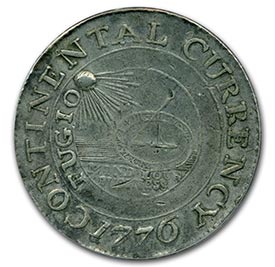
Pre-1776 State Coins (1652-1775)
Colonial and post-colonial coinage in the Americas formed a varied and unique patchwork, mixing with other media of exchange to create a huge variety in commerce. During this time period, foreign coins and colonial issues mixed with wampum, grain, barter and privately-minted tokens for a chaotic system of trade that did not standardize till far later.
Pre-1776 State Coin Design
The history of early United States coins embraces a wide variety of money, not just coins minted within the United States itself. World coins saw common usage across the whole of the United States, and major denominations from countries like the Netherlands, France, and Spain were widely circulated through the 1850s. British coins were commonplace, not surprising considering the American colonies were under British rule. The bulk of coinage was English crowns, shilling and pence as well as the Spanish piece of eight (which laid the groundwork for the Silver dollar).
Foreign coins were not the only circulating currency in the New World. Private issues were also available, and there were circulating coins created by some of the states (most notably Massachusetts, but also Maryland and New Jersey). There were also some issues created under the British royal patent in the American colonies. Though the French did not own territory in the area of the British colonies of the time, they too had coins made by royal patent in the New World, and these also circulated.
Massachusetts Coinage
Massachusetts was authorized by the Crown to make its own coinage. These first coins came in threepence, sixpence and shilling sizes with little but a round Silver planchet and a small mark. Mintmaster John Hull took care of the striking in Boston. These rudimentary coins were vulnerable to clipping and counterfeiting, so they were replaced by the Willow Tree, Oak Tree and Pine Tree designs in succession.
The Lord Baltimore coins were created under Cecil Calvert, the second Lord Baltimore over Maryland. Calvert ordered shillings, sixpence and groats in 1659, and his right to strike coins was upheld by the government of Oliver Cromwell. This issue was small, and though it circulated through Maryland it disappeared from circulation by around 1700. These coins featured Calvert’s portrait on the obverse with the words “Lord of Mary’s Land” in Latin. The reverse of larger coins had the coat of arms of the Baltimore family as well as the denomination in Roman numerals.
New Jersey saw St. Patrick or Mark Newby coins, which were likely struck in Dublin sometime between 1663 and 1672. The General Assembly of New Jersey ruled that these coins were made legal tender in 1682. These coins existed in both farthing and halfpenny form. The obverses have a king playing the harp while kneeling. Both reverses show St. Patrick, but the halfpence show him surrounded by people and the farthing shows him driving away serpents. This coin often has a brass insert over the crown on the obverse, meant to make counterfeiting more difficult.
Some coins were authorized by a British royal patent. These included the tin American Plantations coins of 1688, the William Wood Rosa Americana coins, the Hibernia coins and the 1773 Virginia halfpennies. Of these, all were struck in the New World except for the Hibernia coins, which were created for Ireland and exported to the Americas.
Historical Significance
All of these issues are fairly uncommon today. They were not minted in huge numbers. But among them are several very important issues, including the first coins minted in the English-speaking colonies (the Massachusetts Silver coins) and the first royally authorized coins in the British colonies in America (the American Plantations tin coins.)
Numismatic Value
Most of these coins are expensive but a few can be had fairly cheaply. It depends on the issue. In low grades some are reasonable (including the Hibernia halfpennies). Aside from that, though, these coins are expensive, rare and highly prized. They are also highly individual. Because of the handmade dies, coins can be collected in types based on the die that was used for the strike.
Expand your collection today and shop our assortment of Colonial coins and patterns.

PCGS Products
You need the most up-to-date pricing on your coin collection. That’s why APMEX has partnered with PCGS, the premier grading authority in the world of rare coins, to bring you constantly updated pricing on collectibles and rarities. PCGS has been grading coins since 1986, bringing consistent standards of quality to a fractured industry. In the years since they have remained a source of reliable information on the current collectible and rare coin market.
Historical Significance
All of these issues are fairly uncommon today. They were not minted in huge numbers. But among them are several very important issues, including the first coins minted in the English-speaking colonies (the Massachusetts Silver coins) and the first royally authorized coins in the British colonies in America (the American Plantations tin coins).
Numismatic Value
Most of these coins are expensive but a few can be had fairly cheaply. It depends on the issue. In low grades some are reasonable (including the Hibernia halfpennies). Aside from that, though, these coins are expensive, rare and highly prized. They are also highly individual. Because of the handmade dies, coins can be collected in types based on the die that was used for the strike.
Expand your collection today and shop our assortment of Colonial coins and patterns.




